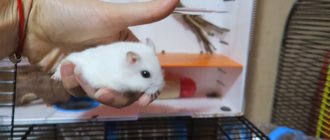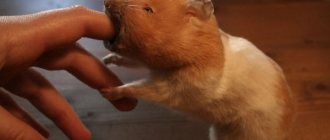When a person decides to have a pet, many people prefer rodents from the hamster order, as they believe that they do not require special care. In fact, in the first time after arranging a cage for the animal, some begin to ask the question why the hamster does not sleep in the house and why it is needed in general. As you know, a pet’s home must be equipped with a running wheel and a specially equipped sleeping place. It is best to choose a larger cage so that there is enough space to install a feeder and water bowl.
Why doesn't the hamster sleep in the house?
Each cage in which a hamster lives should have certain accessories to make life easier. Despite all the possible simulators, it must have a kind of house. It can be made of plastic, wood or other materials. As a rule, they are bought at a pet store, ordered on the Internet or made with their own hands. Often improvised means are used. In any case, the house should be spacious enough. It is recommended to attach it to the bars of the cage. It serves as a sleeping area for the animal and as a storage area. It is there that the animal will carry all its food in order to stock up. This is exactly what they do in the wild and this instinct does not go away. Therefore, there should be enough space for eating and sleeping. If you do not make a hamster house with your own hands, then when choosing in a store, use the following tips.
There doesn't have to be only one house. If the size of your home allows, you can install several. He will definitely like one of them. Then others remove it or leave it permanently.
- The house should be easy to clean. You will need this so that you don’t have to spend a lot of time cleaning in the future.
- Disinfection. It should be easy and without problems or inconveniences. Since you will have to do it from time to time, you should take this into account when choosing an accessory.
- Openings. If it opens, it is easy so that the hamster does not refuse to sleep in the house.
But even despite all the efforts, the animal may not appreciate them and make a bed for itself in another place in the cage. Then the question arises, why doesn't the hamster sleep in the house?
How to equip a pet house
A rodent's house serves as a fortress. Here he likes to relax, build nests, and hide supplies for a rainy day. It is important to remember that the hamster arranges his home according to his own taste. The owners can only choose a house model for their pet and help him in “decorating” the home by throwing napkins, shavings, sawdust, paper, and shreds into the cage. From the proposed options, the animal will independently choose what suits it best.
Some owners prefer to put cotton wool in their pet's house. This material can be used, but only in small quantities. Otherwise, the cotton wool will get tangled between the small fingers of the rodent and cause a lot of inconvenience to the baby.
You can make a house with your own hands from available materials (wood, fabric, ceramics, plastic, plant fibers, wicker), however, it is better to purchase a finished product at a pet store. Nowadays, there are various options for hamster houses.
It is important that the home for the baby is safe, has a stable structure, and does not have sharp corners. And the housing material in which the hamster will rest must be free of all kinds of toxic impurities. Some owners create houses out of cardboard for their pets, but such structures are impractical, and the “fluffies” chew them up pretty quickly.
The size of the home directly depends on the size of the pet. For Djungarian hamsters, the “bedroom” should be smaller than for Syrians. When buying a home for a pet, it is important to remember that the animal can grow. And if the same “Syrian” buys a “bedroom” for a dzhungarik, then one day you may encounter the problem that the hamster is stuck in the house. This situation may seem funny to some, but a frightened animal will definitely not be laughing. From such experiences and pressure on vital organs, the rodent may die.
Most rodent houses do not have a bottom, so cleaning them is not difficult; you just need to lift the structure.
Reasons why a hamster does not sleep in the house
- Smell. Poor quality materials of the product may have an unpleasant odor to the animal. Everything needs to be washed well and disinfected. If the rodent does not sleep in the house, then it does so in another place. Move our accessory there, and put inside the sawdust on which it slept. This will help make the inside smell more familiar and familiar. There is a chance that now he will understand why we tried so hard and will go inside to sleep.
- Heat. Cheap hamster houses are not always well thought out. In summer, your pet may simply feel hot in it.
- Inconvenient. If the pet is not comfortable there, then most likely nothing can be done about it. We need to offer him another house, more spacious.
- Other reasons. The hamster does not sleep in the cage for other reasons that are difficult to determine. For example lighting. Remember that this is a nocturnal animal. It should be dark inside, at least darker than other parts of the cage. You must determine the cause yourself through trial and error. That is, check each described option yourself, but not all at once.
By determining why the hamster does not sleep in the house, you can correct this situation. But remember that this is not critical. If your pet is healthy and active, then there is nothing to worry about. Let him decide where it is better for him to sleep.
Source
The correct daily routine of an animal
Many breeders complain that the rodent sleeps for a very long time. We can say that a pet thinks the same about its owner, who sleeps at night. But what kind of regime do hamsters have?
Hamsters are nocturnal animals, but they have a routine, just like people. To understand the health status of your pet, just look at how much he sleeps. The norm for rodents is as follows:
- if a hamster sleeps 8 hours a day, then this indicates that he is very active;
- sleep at 10 o'clock indicates that the animal is in good physical and mental condition;
- if a hamster sleeps for 14 hours, it means you have acquired a lazy person;
- but if the duration of sleep is more than 14 hours, then not everything is in order with his health.
It is worth remembering one single rule: if the rodent is resting, then there is no need to touch it. You shouldn’t wake him up just to give him a treat or take him for a walk. Wait until the animal gets some sleep, and then have fun with it as much as you want. Teach him that after sleep he begins a period of special activity, games, food, self-care.
If the hamster doesn't get enough sleep, it may bite. It is also not recommended to try to create a regime for the animal that you like. This is not possible, because as mentioned above, the hamster is a nocturnal animal, and it will not be able to stay awake during the day. If he interferes with your sleep, simply place the cage in another room.
Why does a hamster refuse to sleep in his house?
When choosing “furniture” for a Djungarian or Syrian hamster, you should pay attention not only to the size of the house, but also to the material from which it is made. A rodent will be most comfortable in a wooden dwelling, since plastic products can scare away the animal with a sharp, unpleasant odor.
In his house, the hamster not only sleeps, but also uses it as a personal pantry, storing grains and pieces of vegetables in it, because natural instinct forces the animal to stock up for the winter. Therefore, this piece of furniture should be quite large and spacious.
If the pet refuses not only to sleep, but even to enter its home, then this can be explained by several reasons:
- The animal does not like the smell of the product. This problem occurs especially often if the house is new. Before placing this item in the cage, it must be washed and treated with a disinfectant to kill all bacteria and eliminate foreign odors;
- Sometimes a rodent refuses to sleep in a house in the summer because it is too hot for him there;
- Another possible reason that a pet has rejected its home may be that it is uncomfortable and uncomfortable there. You can solve the problem by buying a new piece of furniture for the animal;
- Perhaps the hamster stopped sleeping in the house because his paw was pinched by the door and the pet is simply afraid to enter it. In this case, the door should be removed so that the entrance is open and accessible;
- It may also happen that the animal suddenly begins to use this object as a toilet and naturally does not want to sleep on wet sawdust. If this happens, the product should be washed and placed in the corner of the cage where the rodent sleeps.
How to make a house for a hamster with your own hands
How to find a hamster in an apartment if it has escaped from its cage
Having a pet in your home is a pleasant experience. Most household members usually participate in organizing the life of a new family member. Why not do something that brings the whole family together and make a home for your beloved rodent with your own hands? This event is sure to please everyone, especially children.
House for a hamster made of cardboard
It is much easier to make a house out of cardboard. The easiest solution is to adapt an ordinary box for a hamster’s home, cutting a hole in it for the entrance. You can use a toilet paper roll to create an arched entrance to your home. And now the shelter for the animal is almost ready. All that remains is to instruct the children to paint it with watercolors or gouache, and you can prepare the furry tenant for moving in.
To make a house for your favorite rodent from cardboard sheets, you need to think through the design, draw a drawing and stock up on the necessary tools. To work you will need:
- a sheet of thick cardboard;
- scissors;
- stationery knife;
- PVA glue;
- brush for applying glue.
Cardboard house from a box
Markings should be applied to the cardboard according to the drawing, not forgetting the gluing allowances. Then use scissors to cut out the base of the future house. Using glue, connect the edges and wait until completely dry. After the glue has dried, you can paint the house.
Note! Inside, the cardboard house can be 2-3-three stories high. The more artificially created obstacles that the hamster is forced to overcome, the more energy he will expend. An energetic animal has a much lower risk of developing obesity.
How to make a house for a hamster out of wood
If the family has experience making a birdhouse, then making a house for a hamster will not be difficult. To work you will need:
- multilayer plywood or wood 4 cm thick;
- wood hacksaw or jigsaw;
- drill;
- a crown for drilling a hole;
- drill;
- nails;
- hammer;
- sanding machine or sandpaper.
First of all, using a jigsaw, you should cut out two blanks 14 cm long and two blanks 16 cm long from plywood or wood. The height can be arbitrary, but not less than 9 cm. They need to be thoroughly sanded. A hole of at least 7 cm is cut out on one of the parts using a drill and a crown. This will be the entrance for the hamster into the house. To prevent air circulation from being disrupted, several holes should be drilled in each workpiece. The next stage is to fasten all the parts of the house together with nails.
Important! Make sure that no nails stick out. Otherwise, the animal may be injured.
Container house
Homemade houses for hamsters made from plastic containers stacked on top of each other are very common. To make such a home you will need:
- 3 containers with lids (without handles) measuring 20x25 cm;
- awl;
- scissors;
- wire or double-sided tape.
Container house for a small pet
Important! Before you start making a house from containers, you need to make sure that the plastic is non-toxic and odorless.
The first step is to cut round holes in the lids (except for the top one). In the lower container, it is necessary to cut out the entrance in the side panel so that it closes like a door.
In order for the hamster to move along the “floors,” you need to build a ladder or adapt sticks, securing them in such a way that the pet does not fall off. Using an awl and wire, it is necessary to fasten the parts of the structure together. You can use double-sided tape, but then you will need to replace it after each wash of such a house.
Note! Before placing your pet there, you should make sure that the structure is reliable.
DIY coconut house for dzhungarik
For miniature hamster breeds, a house made from coconut is perfect. There is no doubt about the environmental friendliness of this home. In addition, a house made of coconut will definitely be too tough for a pet. The algorithm of actions is as follows:
- The first step is to choose a fruit that is suitable in size for the hamster. The coconut should be ripe, but not show any signs of rot.
- Next, you need to remove the milk from the coconut. To do this, you need to make a hole in the coconut and drain the contents.
- The next step is to work on the hole that will serve as the pet’s entrance. To do this, you need to place the coconut on the table and mark the hole.
- The most difficult step is to make a hole in the hard shell of the fruit. The entrance should not be made too small, otherwise the baby risks getting stuck in the passage. An excessively large hole will not retain heat inside the house.
- The final stage is removing the pulp. Through the hole made, you need to scrape the pulp from the inner walls of the coconut, thoroughly wash and dry the almost finished housing.
For your information! If the coconut house is not secured inside the cage, it will roll around. The pet is unlikely to like this. Therefore, it is worth taking care of the reliable fastening of the house to the floor or wall of the cage.
Coconut house for dzhungarik
Why doesn't the hamster leave the house?
There are also the opposite situations, when a furry pet does not leave its house for a long time. Why does this happen and what should the owner of a miniature rodent do in this case?
If the hamster was just brought home from the pet store, then it needs several days to get used to the new environment. These cute creatures are very shy, so it is quite normal for the animal to hide in its home for the first time and not come out.
Hamsters are afraid of noisy sounds, so the hamster could have been frightened by loud music or screaming and preferred to retreat to the only safe place for itself - its cozy house.
If there is a cat or dog in the house, then perhaps it was these animals that scared the miniature rodent.
But, if at the same time the pet does not leave its home, even to eat or drink, then the reason may lie in some kind of disease. In this case, the owner needs to remove the animal from the house and inspect it. At the slightest suspicion of illness, your pet should be taken to a veterinarian.
How to find a hamster?
If your pet runs away, first of all, you shouldn’t panic. It may not be possible to immediately catch a hamster in the house, and it will take time to find the fugitive.
Important! Actively searching for a runaway pet by moving or turning over furniture carries the risk of crushing a small, fragile animal. And slamming cabinets, interior doors and stomping will not only not help you find it, but can even scare the hamster away.
If the hamster has escaped, then you need to ensure that it remains as safe as possible until it is returned to the house. You should tightly close the door to the balcony, from where it can fall, and remove household chemicals, medications, and any toxic substances higher than the floor level. Cats, dogs and other animals that can cause harm should be isolated for a time in a room where the pet is definitely not present. Otherwise, they may find the hamster faster than the owner.
The hamster is predominantly nocturnal. He feels calmer in the dark and becomes more active as dusk approaches. Therefore, it is much easier to find a lost animal in the evening.
It is necessary to create silence, turn off the lights in the apartment and listen. The fugitive will detect a grinding or rustling sound, after which you can carefully approach the place where the sound is coming from. It is important at this stage not to scare the fugitive, otherwise he may hide deeper and get completely lost, and you risk not finding him for a long time.
Another way to find an escaped hamster is to dust the floor with flour and sprinkle food on it. A hungry hamster will come running to satisfy its hunger, and after that it can be found by following its tracks.
Hamster doesn't sleep in the house?
The cage where the hamster is kept is equipped with a house. This hamster furniture is sold in pet stores and is made of wood or plastic. Some owners put an upside-down flower pot instead of a house - this is an exclusive option for arranging a hamster’s life.
If you decide to buy a house, then experts advise choosing one that can be attached to the wall. It should be spacious enough. This is where the hamster will sleep and store his supplies. Choose a model that is easy to open, easy to clean, and easy to disinfect – and this will be the best option for him. Although, it is not a fact that this cute living creature, despite all your efforts, will not prefer to rake sawdust in the corner of the cage and “nest” there. And you will be tormented by the question: why doesn’t the hamster sleep in the house, what should I do?
What is the reason?
If the hamster immediately rejected the house, perhaps he didn’t like something. Smell, for example. Move the house to the place he has chosen for the nest and put sawdust from his improvised nest in it. There is a possibility that the house will become “more dear” to him and he will move there. Or maybe it’s hot for him in the house (let’s say it’s summer), and he chose a more ventilated option for himself.
There are also situations when a hamster leaves the house outside of the summer, and there is no apparent reason for this. And yet, it’s most likely the smell that appeared there. Therefore, we recommend that you thoroughly wash and dry the house with a disinfectant. And then proceed as in the previous case: put sawdust there with its “native” smell. This should get him back to the hut to sleep.
There is no need to worry too much about the fact that the hamster does not sleep in the house. This is a solvable problem. If he is healthy, active, and eats with appetite, then this small glitch can be ignored. In the end, let him sleep where he is comfortable.
Source
How to catch a hamster in an apartment?
The pet must be caught extremely carefully. Under no circumstances should you grab roughly or try to cover with heavy things (bowls, pots). It is better to let your pet escape than to cause injury.
The safest way to catch it, although not very fast at first glance, is to lure the hamster or dwarf with food. In the wild, he will certainly get hungry and miss treats and toys. And if the hamster is able to find meager food within the apartment, then he will have to return to the cage for a drinking bowl.
Treats and baits
Rodents are afraid of open spaces, so it is better to place baits not in the center of the room, but along the periphery. Capture options:
- The cage works well as bait.
Inside, in a visible place that the pet can easily find, you need to put a drinking bowl with clean water and place the food that the hamster likes most. Usually these are nuts, seeds, crackers, vegetables or sweet fruits. When the animal is inside, the owner simply needs to close the door.
- A simple bait is made with a tasty treat and a light cardboard box or towel. The hamster's bowl is placed on the floor, or food is poured in. This requires the owner's constant attention and silence. When the pet smells food, it will run out of the shelter. At this point, it is covered with a box or light cloth. This must be done carefully to minimize stress and not cause harm to the animal.
Important! You should not wash the cage before the hamster is back in place. The familiar smell attracts him back, instills a feeling of security. He is more likely to return if he senses the marked territory.
Toys
A hamster may become bored with freedom due to the lack of favorite attractions: wheels, balls, ladders, tunnels. All this can be placed next to the place where he was last seen. It is possible that soon after this the animal will come out to engage in its favorite pastime.
Safe traps
Homemade traps can help catch an escaped hamster and at the same time keep your beloved pet safe and sound.
This trap is suitable for animals that do not like to be held and are not used to it. It is made very simply. One end of a paper towel or toilet paper roll is sealed so that your pet cannot escape. A treat is poured inside. The open end of the trap tube is placed at the place where the escaped hamster is supposed to be hiding. Once it is in the sleeve, the owner can safely move it home.
- Bottle trap.
This is a rather complex design. It is assembled from a plastic bottle and rubber bands. The bottom of the bottle is cut off on three sides so that it rests on only one wall. The cut part is folded back and fixed, as indicated in the photo, with an elastic band. A cardboard bridge is placed inside the trap, which should preferably be rubbed with something tasty and aromatic, such as peanuts. The treat itself is placed deep in the bottle. The hamster will climb inside for food, but will not come back out, and the owner will be able to easily find him.
A bottle trap is theoretically dangerous for the animal, since the rubber bands can come off or burst. With this method of catching a fugitive, it is better to foresee a similar outcome of events.
A large amount of hay or sawdust is placed at the bottom of the bucket so that the pet does not hurt itself. A ladder is built to the top, which is a ladder made of books. A piece of treat is placed on the middle and last step.
The hamster will climb the ladder out of curiosity and the smell of food, and when it ends up on the piece of paper, it will slide to the bottom of the bucket. Due to the high walls, the hamster will not be able to escape without the help of its owner.
Why doesn't the hamster sleep in the house?
When a person decides to have a pet, many people prefer rodents from the hamster order, as they believe that they do not require special care. In fact, in the first time after arranging a cage for the animal, some begin to ask the question why the hamster does not sleep in the house and why it is needed in general. As you know, a pet’s home must be equipped with a running wheel and a specially equipped sleeping place. It is best to choose a larger cage so that there is enough space to install a feeder and water bowl.
How long can a hamster sleep?
A small rodent can sleep up to 10 hours a day. To protect themselves from dangers that may arise at night, hamsters sleep during the day. Syrian and Dzungari are no exception to this rule. Some go to bed at 9 am, and others at 7, each rodent chooses the optimal time for itself.
An animal's sleep is greatly affected by changes. If he is moved to another place or another house, he will begin to behave completely differently. A rodent has two types of behavior:
- Activity is when a pet shows interest in everything that is around it. He settles down in his own house. During this period, the animal has little time to sleep. Hamsters adapt to a new place within seven days.
- The second type of behavior is sleep. The hamster sleeps in his house all day and leaves it only to eat and drink. How much do hamsters sleep during this period? A rodent can sleep about 20 hours a day.
This is normal animal behavior and there is no need to worry. If you hear from someone that a hamster does not sleep during the day or sleeps at night, do not believe it. These animals have a regime opposite to ours. At night they are awake and constantly spin their wheel, which prevents their owners from sleeping. And during the day they sleep peacefully in their house.
Remember, it is impossible to wean this animal from sleeping a lot, it is inherent in their nature.
Purpose of a house in a pet's cage
Buying a house for your pet is easy. You can buy the accessory at a pet store, order it online, or even make it yourself. At first, it is recommended to install not one, but several, so that the hamster can make his choice. It should attach freely to the cage rods. The main purpose of such an accessory in the animal’s cage is to organize a sleeping place for it and a warehouse for dry food.
When choosing a house, you should pay attention to such points as:
- ease of cleaning;
- ease of disinfection;
- ease of opening.
Reasons for not wanting to sleep in a house
Despite the fact that an accessory for a hamster can cost a lot of money, since it is made of high-quality, environmentally friendly material, many are faced with the reluctance of the hamster to be inside. The main reasons are considered:
- the presence of a peculiar odor - usually a similar phenomenon is observed if the accessory is made of low-quality material. To eliminate the smell unpleasant to the pet, it is recommended to disinfect the home, move it to the place where it sleeps and put the sawdust from which its nest is made inside the house. This way the smell will become familiar to the animal;
- heat - not all accessories are equipped with a kind of ventilation system. If the pet is hot in it, he will refuse to sleep inside;
- lack of amenities - perhaps the baby does not have enough space inside a small home. In such cases, you can replace it with a larger one.
In addition to the above, there are other reasons that explain the reluctance to climb into a specially designated place while sleeping. Considering the fact that this is a nocturnal animal, it is worth making sure that as little light as possible falls on the sleeping place during the daytime.
How to attract your pet's attention to his sleeping place?
Many novice breeders of hamsters complain that their pets refuse to accept houses installed in cages. Don't be afraid of this. First of all, you need to make sure that the baby is comfortable in his living space. Often you have to purchase several similar accessories so that the animal can make one of them its home.
To attract your pet's attention to a new accessory, sometimes it is necessary to place a small amount of sawdust in it, in which the baby previously slept. Many people recommend putting a small amount of the animal’s favorite food there. In such cases, the likelihood that the hamster will settle into a new sleeping place increases. It is important to carefully observe the behavior of the individual to understand whether it is healthy, and then draw conclusions explaining the reasons for abandoning the house.
If your pet does not have bald spots or matted fur, his eyes are clean, there are no signs of diarrhea on his fur, and he has calm, even breathing, there is no need to panic. Perhaps after a while the baby will show interest in an unusual sleeping place. If this does not happen, the accessory can be left if it does not take up much space. If the hamster cannot move normally around the living space, it should be removed until better times.
Allow your hamster to get fat
A fat hamster may look cute, but it can be dangerous for his health. Excess weight puts a lot of stress on bones and joints. Therefore, proper nutrition and daily exercise are simply necessary for your pet.
By following these simple rules, your pet will delight your household with its cheerful appearance and disposition for a long time. The most important rule is care and attention.
- Why do hamsters run away and how dangerous is it?
- What to do if your hamster goes missing?
- How to lure a hamster out of hiding?
- So that this doesn't happen again
One day the hamster Mango was very bored in his cage. To somehow entertain himself, he began to play with the shiny door - stand on it with his paws and poke his muzzle into the latch. And, lo and behold, the door opened! (It’s clearly time for the owner to change the locking mechanism). Mango is free! He deftly jumped from the table to the chair, carefully went down to the floor and went to explore the huge three-room apartment. But, in addition to the hamster and the owners, it was also home to a Jack Russell terrier, Jesse, and a two-year-old baby, Leva. It’s scary to think how many dangers could have fallen on the cheeks of the handsome fugitive if not for his responsible owner... He regularly read articles on the Tail News portal and knew how to act in such a situation. Do you want to know how to quickly find a missing hamster? Then let's go!
Why do hamsters run away and how dangerous is it?
Hamsters could compete for the title of the most curious pet on the planet!
These animals are very active, dexterous, playful and smart. If the hamster has a chance to escape from the cage, believe me, he will not miss it! But will the “big trip” benefit him? Any rodent specialist will answer that no. For a full, happy life, a hamster needs a spacious cage. They are generally not recommended to be allowed out for walks outside of the park.
It's only in theory that a hamster's escape seems funny. In practice, the risk is too high that this adventure will end in failure. What awaits the hamster in the apartment is not an exciting Disney Land for rodents, but very real dangers. These include small objects that can be swallowed, sockets and cables that can give you an electric shock, narrow gaps where you can get stuck, and heavy objects (as well as your feet) that you can accidentally get under. And if the cage is installed on a high surface, then you won’t have to go far to find danger. A hamster can fall and seriously injure itself as soon as it begins its journey.
What to do if your hamster goes missing?
Ideally, it is better to prevent situations where the hamster can escape from the cage. But we are all living people, and no one is immune from mistakes. So what should you do if your hamster runs away? How to quickly find him before trouble happens? Let's take it step by step.
- Try not to panic and inspect the cage carefully. Check all the nooks and crannies: the house, the tunnels, the hammock. Surely the hamster is not hiding somewhere within his home?
If there really is no hamster in the cage, warn all family members: let them be careful!
- Animals and small children who may unknowingly cause harm to the pet should be isolated in another room or closely monitored. Even if your cat or dog was exceptionally friendly towards the hamster, it’s not worth the risk. Hearing rustling behind the chair, the pet may behave not like a “friend of rodents”, but like a hunter.
- Close the door of the room where the cage is located. Cover the gap under the door so that a savvy rodent does not run to another part of the room and complicate your search.
- Carefully inspect the area closest to the cage. Don't run into the next room to search. At first after escaping, the hamster most likely will not run far and will sit out somewhere nearby.
- Remove rodent and insect poisons and household chemicals so that the hamster does not taste them.
- While searching, move along the walls and inspect the space below. Hamsters usually do not go out into the open and do not try to climb higher. Inspect the space behind cabinets, cracks under furniture, shoes, carpets, and any secluded places where your furry can hide.
- Do not move furniture. This could cause you to hit and seriously injure your hamster.
- Do not make noise. Ideally, turn off all sources of noise, create silence in the room, turn off the lights, sit quietly in a chair and listen. Most likely, after a few seconds or minutes, the hamster will give itself away by rustling.
- Calling a hamster is completely pointless. It is not a dog or a social rodent like a rat. He won't run into your arms. On the contrary, hearing your loud, excited voice, the hamster will get scared and sit in the shelter for a long time.
How to catch a hamster if you've blown its cover? It is best to put treats on your palm and lure the baby. If the hamster is not tame, catch it with a net (or hat). It is better not to use heavy objects such as pots and basins: this can cause injury to the fragile rodent and will greatly frighten it.
How to lure a hamster out of hiding?
A runaway homa is unlikely to miss its owner and will definitely not run out to meet you. But he will miss food very soon.
On the Internet you can find many options on how to lure a hamster out of its hiding place with a treat. Some of them are very creative. But we recommend using the most effective and safest method. Simply place an open cage on the floor in the center of the room and place your traveler's favorite food in it. Feeling the familiar smell of home and favorite food, the homa will return to the saving walls of his shelter. All you have to do is close the door behind him.
For greater reliability, scatter “bread crumbs” along the way to the cage: these can be seeds or grains. The hamster will use them to get to the cage. The main thing is not to overdo it with their quantity, otherwise the rodent will eat and return to its temporary shelter.
Other methods, such as luring the hamster into a bucket or bottle, often result in injury or have no effect at all.
After catching the rodent, carefully examine it. Was he hurt? Did you hurt yourself? If damage is found, contact your veterinarian.
“My hamster is a bundle of energy, and he doesn’t sleep during the day.”
When a person decides to have a pet, many people prefer rodents from the hamster order, as they believe that they do not require special care. In fact, in the first time after arranging a cage for the animal, some begin to ask the question why the hamster does not sleep in the house and why it is needed in general. As you know, a pet’s home must be equipped with a running wheel and a specially equipped sleeping place. It is best to choose a larger cage so that there is enough space to install a feeder and water bowl.
Ceramic houses
Relatively recently, housing for rodents made of ceramics has appeared on sale. This material is safe in terms of toxicity, retains heat well, but is much more expensive than housing made of plastic or wood. A ceramic house, in addition to its high cost (from 300 rubles), has another inconvenience: if it falls from a height, it can break. Therefore, when cleaning your pet’s cage, you must ensure that the “bedroom” does not fall.
Houses made from this material have very original designs, colors and sizes. You can find housing for rodents in the form of vegetables or fruits. A small pumpkin with one entrance and no windows looks especially beautiful. A house in the shape of a “piece of cheese” with holes in its walls will become not only a place for the animal to sleep, but also a fascinating labyrinth.
Purpose of a house in a pet's cage
Buying a house for your pet is easy. You can buy the accessory at a pet store, order it online, or even make it yourself. At first, it is recommended to install not one, but several, so that the hamster can make his choice. It should attach freely to the cage rods. The main purpose of such an accessory in the animal’s cage is to organize a sleeping place for it and a warehouse for dry food.
When choosing a house, you should pay attention to such points as:
- ease of cleaning;
- ease of disinfection;
- ease of opening.
“My hamster is a bundle of energy, and he doesn’t sleep during the day.”
“My hamster is a bundle of energy, and he doesn’t sleep during the day.”
Dear friends, among your letters there are no, no, and there will be reproaches like: “Well, you wrote ... but in fact, everything is happening with me exactly the opposite.” Of course, on the one hand, it’s nice when readers carefully read our articles, argue, express agreement or, on the contrary, disagreement, a discussion ensues, during which the truth emerges. On the other hand, we select for publication materials written by professional experts with many years of experience. Can they get lost and get lost in three pines? The issue also deserves serious discussion. But what turns out to be completely different: as soon as you enter into correspondence with the authors of “critical” letters, a completely different picture immediately begins to emerge. And miraculously it turns out: the professionals were speaking strictly to the point!
Here is one of such letters. Its author accuses us of incompetence. “I bought a Syrian hamster from a pet store. Of course, I bought a cage, accessories, and toys, everything was as advised. I always kept in mind that hamsters are nocturnal. Not so for me. It seems like they put a magic battery in mine. At first it seemed to me that he was not sleeping at all - he was constantly climbing around the cage, spinning in a wheel, etc. Finally I saw the hamster sleeping. You wrote that hamsters like to hide in a secluded nook, bury themselves somewhere, and adore solitude. I see that this is not so: my pet sleeps completely openly, falls asleep in the same place where he was playing a minute ago.”
What to answer the reader? We can say categorically: hamsters are nocturnal animals. At least they are considered that way. But our author sees the opposite! A dangerous mistrust is born. In fact, life itself throws up interesting surprises. In practice, it turns out that there are many variants of the norm; you just need to dig deep into the details.
From the letter we see: “bought recently, at a pet store.” Can you imagine a typical pet store enclosure containing a dozen and a half hamsters? But the Syrian hamster, please note, is a solitary animal and does not like company. This means that the lifestyle he led in the store was clearly not to his liking; in other words, the hamster is already initially programmed for stress, for certain behavioral problems. Which he splashed out as soon as he found himself at home in his “personal” cage.
That's why we tell our readers: buying pets in pet stores is not always a good idea. Inconsistencies in behavior similar to those described by the reader can be observed for up to ten days, sometimes up to several weeks. If the animal is provided with proper living conditions, then gradually everything will return to normal, and the “hyperactive” hamster will become the way we describe it in our publications. In the meantime, at first, the pet will not live according to your schedule, but according to the store’s schedule. And the author will need a lot of attention and patience to force the hamster to live according to its natural clock.
Plus, judging by the letter, a very young animal was purchased, which is really at the peak of activity. Although he is small, he sees perfectly: around him there are new faces, different surroundings, foreign (not store) smells, of which there are a minimum of familiar animal smells. New food, a completely different way of life. For a hamster, everything is new, everything is interesting. Again, a little time will pass, and the animal will get used to everything, everything around will become ordinary.
By the way, one remark in the letter sounded fair: hamsters do not always bury themselves somewhere to sleep, they dig holes. However, almost all hamsters are grateful to their owners when they respect their right to “privacy” and equip them with some kind of secluded nook or house. But what place the animal chooses to sleep depends on itself, on its mood. However, take a closer look at your pet: you will see him in the house quite often. I return to the reader's letter again and again. Still, I am inclined to believe that in this case the hamster is simply having fun. While there is strength. I think this behavior will continue for some time.
By nature, all hamsters, including Syrian ones, strive for an orderly and measured life, subject to a strict schedule. I repeat - in the very near future you will not recognize him - he will fall asleep at the same time, eat food according to the schedule, etc. Well, what about the “sins of youth” – who among us hasn’t had them! Nevertheless, I express my readiness to continue the discussion. Let other hamster owners get involved too. Be sure to write how things will develop.
Quoted in: Hamster Sleep Habits. Author: Martha Boden, . Photos used from open sources.
My experience with homa disease. EVERYONE SHOULD KNOW THIS.
To help those who have the same symptoms.
When your hamster starts behaving strangely, gets sick, or suddenly you urgently need advice, immediately open Google and start typing in your question.
Daisy was my first hamster. Furry family member, small child. Our princess. We spent every evening together.
Fluffy Syrian hamster. I very often opened Google and looked for information on care, nutrition, appearance, etc. I often found what I needed, but these were posts on forums where, unfortunately, there was no ending to the story.
Daisy passed away today. She was one and a half years old, she could have lived longer, but unfortunately she could not cope with pneumonia. And this is the worst thing, that she died not from old age, but from a disease that could have been prevented and cured if the symptoms had been immediately noticed. Let my sad experience be a lesson for everyone. Let this story have an ending. I want you not to repeat my mistakes.
Throughout her life, Daisy was ill 2 times, 2 of them were fatal.
Poisoning (bloating, inactive behavior, no appetite).
She was one year old. It so happened that she ate white cabbage and raw potatoes. As you know, this is a heavy food for hamsters, which can be fatal!
1- She didn’t leave the house all evening (it happens that in the evening we find ourselves in a period when she’s sleeping, and we go to bed without seeing her). The next day it became clear that she did not go out at night, the food remained untouched.
2- We took her out of the house, she looked at us, did not utter a sound and did not move. She just sat calmly on her hand and didn’t run anywhere (which is very surprising).
3- It’s worth remembering right away that it was not as usual. New bedding, toy, food, sand? We remembered about cabbage and Google to help us. We found that you can solder a hamster with a dill solution. We crushed the dill seeds, poured hot water (I think it would be better to boil), and served her the warm solution. We didn’t have a syringe, we served it on a spoon, she got 2-3 drops. The next morning she was already running in the wheel and ate all the food.
4- Why did Google come to our aid, because it was night, and all the clinics that I called did not treat “exotic animals” or offered to make an appointment with a qualified veterinarian who is available for appointments on certain days. If you have a hamster, it is better to immediately find a clinic that treats them and works around the clock, because hamsters are nocturnal animals, more often than not you will notice that something is wrong with them already at night.
5- This story ended well. I had dill seeds and just wanted to plant them on Daisy's windowsill.
Result:
-Always Google what a hamster can eat!! Even when it seems to you that it is completely ordinary food! Phrase: “Yes, in nature they generally eat just about anything!” inappropriate here. Hamsters don't know what they can eat and what they can't, so you are responsible.
-Buy dill seeds. Hamsters often experience indigestion. If you didn’t notice, he’s already chewing your flower or collecting crumbs from the table.
-Immediately find a VETERINARY CLINIC. There are very few hamster specialists.
Colds, pneumonia (eyes fester, weakness, wheezing, rapid breathing).
I don't know exactly when it started. Perhaps she cared so much in one day, or perhaps it lasted for several days. But I will capture as much time as possible.
1 - Mon - morning. I noticed that one eye was somehow closed and they were wet, it was not clear whether she had just stood up and that’s why she was so wrinkled, or whether something was wrong. But she behaved normally. I was running, my appetite was good. We left for work. In the evening she was already as usual, not a hint of wet eyes. Just in case, we washed everything and changed the bedding.
2- Wed night. Daisy was making strange sounds, not a squeak, not a sneeze, but some kind of chirping. Now I think that perhaps it was a cough; few people know how hamsters cough. She looked normal, we assumed that she was just washing herself in the house, she sometimes made a couple of such sounds.
3- Thu- we bought her hazel sticks, new sand for cleaning, food. This purchase later led us astray.
4- Sat-evening. Daisy slept for a long time again, we didn’t see her that evening, which was a big mistake.
5- Sun-evening. Daisy came out of the house and was in a terrible state! The eyes were festered and there was blood. We decided that it was because of the new sand or that we had gotten some bad sawdust - here we were wrong (((
-We washed her eyes with chamomile. They removed everything from the cage, washed it and left only the house, they didn’t even put down the sawdust.
- An hour passed, Daisy left the house and could not walk normally, she fell on her side, her eyes were stuck together again. In an hour.
- of course, an urgent call to the clinics, who will take the hamster at night? Google symptoms. On the 8th call I got to the right place, we were offered to give the hamster cycloferon (1/16 (1/4 in half, then in half) part of the tablet or intramuscularly). But it’s one thing to give dill to drink, another thing to give serious medicine. We got ready and took Homa to the hospital. By the time she arrived, she was just lying there and not moving. There was rapid breathing.
The veterinarian listened to his breathing (there were wheezing), conducted an examination, tried to check the temperature, but to no avail. All symptoms pointed to a cold. They gave her 5 injections! They left her for observation overnight, but immediately said that she had little chance, her condition was too bad + her age. This morning they called and said that she was gone...
Result:
-look at the hamster every day.
-If you notice something strange, then immediately find the reason.
-And most importantly, Khomas are very sensitive to temperature changes. We had heat, but then the gas was turned off for 2 weeks; when we were at home, the heater was working; when we left, it was turned off. The summer in our region was cool, perhaps she caught a cold because of this, and on Saturday while cleaning I opened the window, Daisy was far from it, but there was a draft and that was enough for her. It was the last hot day of summer outside, today it was cold, +7 degrees.
PS. This is my first review - I apologize if anything is wrong and for any mistakes.
A hamster is often purchased because it is a small and fairly unpretentious animal. It takes up very little space, and watching its fuss is a pleasure. However, even though the pet is undemanding in care, owners sometimes make certain mistakes in its maintenance that should not be made.
Reasons for not wanting to sleep in a house
Despite the fact that an accessory for a hamster can cost a lot of money, since it is made of high-quality, environmentally friendly material, many are faced with the reluctance of the hamster to be inside. The main reasons are considered:
- the presence of a peculiar odor - usually a similar phenomenon is observed if the accessory is made of low-quality material. To eliminate the smell unpleasant to the pet, it is recommended to disinfect the home, move it to the place where it sleeps and put the sawdust from which its nest is made inside the house. This way the smell will become familiar to the animal;
- heat - not all accessories are equipped with a kind of ventilation system. If the pet is hot in it, he will refuse to sleep inside;
- lack of amenities - perhaps the baby does not have enough space inside a small home. In such cases, you can replace it with a larger one.
Plastic houses
Plastic houses are in greatest demand among livestock farmers. They are quite durable and reliable, but some hamster owners claim that such housing is poorly ventilated. And another disadvantage of such a house is that while testing everything around it, the rodent can swallow plastic and get sick. But such opinions are wrong.
Modern plastic houses for hamsters are made of high-quality materials, they are safe for animals, easy to clean, simple and convenient to use. The price of plastic housing is quite acceptable for most livestock farmers (from 50 rubles). Such models are distinguished by a variety of shapes, layouts and colors. Pet stores sell "bedrooms" with windows, colorful roofs, balconies, stairs and other decorative elements.
Why does a hamster become torpid?
You and I know that it is common for many animals to fall into a state of torpor during the winter. This makes it easier for them to tolerate low temperatures and lack of food. In a state of hibernation, metabolic processes in the animal's body slow down, the body saves energy. At the same time, breathing and blood circulation can be heard, although the body temperature is reduced.
If a domestic hamster, whether a dwarf or a Syrian, finds itself in similar conditions - it does not have enough food, it is kept in conditions that are not comfortable for it, it can fall into a state of torpor. But if the room is warm, the rodent has food in the feeder, and the owner finds the lifeless body of his pet, there is very little chance that he suddenly decided to hibernate. Rather, death came. And there may be many reasons why this happened. Errors in care, improper diet, illness, injury... There is always something that can explain the condition of the rodent.
Why do they hibernate?
A hamster sleeping for long periods of time is not a good thing.
If an animal sleeps all day and night for several days, then this is torpor. For rodents living at home, this is not a normal process, because there are no seasonal changes in the premises. Therefore, it is worth finding out why the hamster constantly sleeps and does not run at night.
Causes of numbness at home:
- The air temperature is too low. When the temperature in the house drops sharply, animals trigger the same instinct as their wild relatives. Therefore, it is better that the air temperature is not less than 15 degrees. Otherwise, numbness will set in instantly.
- The room is constantly dark. It is not recommended to keep rodents in the sun, but darkness also has a negative effect on them. Homa associates constant darkness with shortening daylight hours.
- Poor nutrition. Lack of vitamins and minerals in a hamster's diet can also lead to torpor. Therefore, in order not to bring the animal to such a situation, it is worth feeding it correctly. Give not only grain, but also fruits and vegetables.
- Stressful situations. Severe stress can put an animal into a coma. He will constantly sleep, which will allow him to survive such a shock.
More often, stress for such animals comes from the breeder’s untimely desire to play with him. You should not touch him when he is sleeping or eating. Such irritation can drive him to stupor.
But this is not the main cause of stress. Most often it becomes fear. At the same time, the homa literally loses consciousness. Therefore, in order for your animal to lead a normal life, it must eat properly, not be stressed and be in a normally lit room.
Symptoms
People who encounter this phenomenon for the first time cannot immediately identify numbness. In a state of sleep, hamsters breathe slowly and their heart rate decreases. The rodent's entire body goes into a kind of economy mode. Body temperature during this period is within normal limits. Sometimes the pet may get up to eat. With the arrival of spring they wake up.
Main symptoms of numbness:
- the animal does not move;
- body temperature drops;
- the pet does not respond to its name;
- the animal breathes, but very weakly.
A pet can sleep in this state for 2 months. To check whether a Homa is breathing or not, just hold a mirror to his nose. If it fogs up, it means the rodent is simply numb.
How to attract your pet's attention to his sleeping place?
Many novice breeders of hamsters complain that their pets refuse to accept houses installed in cages. Don't be afraid of this. First of all, you need to make sure that the baby is comfortable in his living space. Often you have to purchase several similar accessories so that the animal can make one of them its home.
To attract your pet's attention to a new accessory, sometimes it is necessary to place a small amount of sawdust in it, in which the baby previously slept. Many people recommend putting a small amount of the animal’s favorite food there. In such cases, the likelihood that the hamster will settle into a new sleeping place increases. It is important to carefully observe the behavior of the individual to understand whether it is healthy, and then draw conclusions explaining the reasons for abandoning the house.
If your pet does not have bald spots or matted fur, his eyes are clean, there are no signs of diarrhea on his fur, and he has calm, even breathing, there is no need to panic. Perhaps after a while the baby will show interest in an unusual sleeping place. If this does not happen, the accessory can be left if it does not take up much space. If the hamster cannot move normally around the living space, it should be removed until better times.
Escape can be prevented
You can reduce the number of escapes of a furry adventure lover if you figure out what pushes him to exploits. Prevention of escapes is quite simple, although the capture quest can add vivid impressions.
- A common reason is being kept in a poorly closed cage. A curious animal explores the territory to which it has access. In trying to go around and mark new areas, he may get lost. Carefully monitoring the condition of the cage and making timely repairs is much easier than discovering that the hamster has escaped from the cage and crawling along the floor, trying to look under the sofa. The cage should be metal, wooden twigs provide shelter for the hamster literally for one tooth, and cardboard boxes for carrying are even simpler.
- The hamster was scared. If there is no house in the cage where you can hide from prying eyes, you have to look for a more reliable place. The cage is often placed taking into account the interior, but the needs of its occupant are not taken into account. Living next to the TV on, under the scorching sun, or on a noisy refrigerator will not be pleasant for a hamster. A vacuum cleaner carelessly turned on next to the cage, camera flashes, the proximity of a cat or dog - any hamster would run away in horror at the first opportunity. If you provide the animal with comfort and peace, he will always choose his own house.
- A nocturnal animal, the hamster wakes up in the evening. If you bother him all day, pull him out of his cage and demand communication, the tortured animal will dive into the first crack he comes across in order to sleep at least a little. The behavioral characteristics of domestic hamsters are inherent from birth and will have to be taken into account. The joy of communication must be mutual, otherwise it is not joy, but violence.
- a hamster living in a glass aquarium cannot climb up the glass, but will gladly climb onto a running wheel, house and other objects in its home, and from there jump out;
- smart animals will not ignore a slightly open door or a bent twig in a cage;
- advanced animals can figure out how to move the bolt;
- Hamsters often disappear from view when they are taken out of the house to communicate with their owner. If you need a distraction, the animal needs to be returned home for its own good.
Where could the animal be hiding?
Rodents like dark, narrow spaces where they can hide or crawl around in search of adventure.
The main places where a hamster can escape:
- spaces under furniture (sofas, cabinets, armchairs);
- various boxes, drawers, open shelves of cabinets;
- places with free access to treats (buckets of apples, a cupboard with sweets);
- bed linen, bedspreads, pillows.
Important! If this is not the first time your hamster has escaped from its cage, it is advisable to check the place where it could have been found before.











